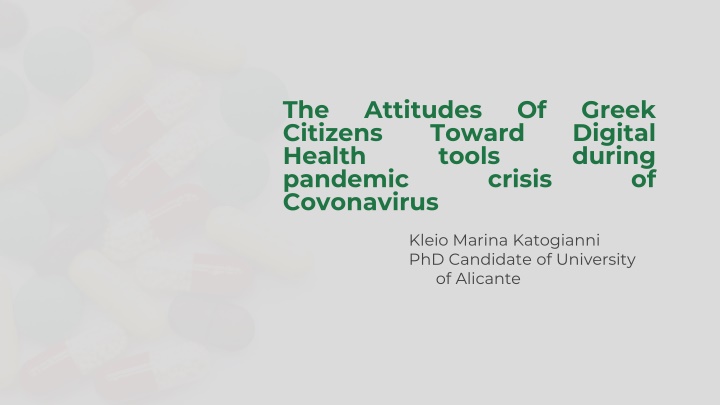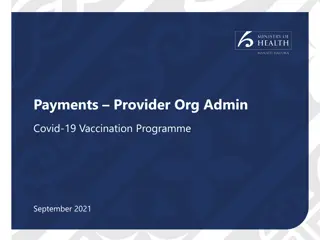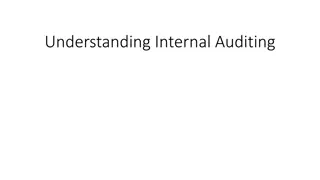Certification of Internal Controls Over Payment Process
Explore the requirements, overview, and importance of certifying internal controls over the payment process. Understand the annual certification process, resources, and results of past assessments to support just and correct payments.
Download Presentation

Please find below an Image/Link to download the presentation.
The content on the website is provided AS IS for your information and personal use only. It may not be sold, licensed, or shared on other websites without obtaining consent from the author.If you encounter any issues during the download, it is possible that the publisher has removed the file from their server.
You are allowed to download the files provided on this website for personal or commercial use, subject to the condition that they are used lawfully. All files are the property of their respective owners.
The content on the website is provided AS IS for your information and personal use only. It may not be sold, licensed, or shared on other websites without obtaining consent from the author.
E N D
Presentation Transcript
The Citizens Health pandemic Covonavirus Attitudes Of Greek Digital during Toward tools crisis of Kleio Marina Katogianni PhD Candidate of University of Alicante
CONTENTS 01 02 03 04 CONCLUSION AIM METHODOLOGY RESULTS
INTRODUCTION The technology is changing rapidly having an impact on our lives. Digital health is the convergence of digital and genetic technologies with healthcare. The studies about the attitudes of Greek citizens toward eHealth tools is limited. Nevertheless, the results of previous research find Greeks skeptical .
Giannouli & Hypantis 2017: This research investigated the attitudes of health professionals, students, and ordinary citizens towards E-health. The citizens showed a negative perception of the benefits. Giannouli et al., 2021: This study replicated the first research and compared the satisfaction of Greek citizens with residents of the Balkans. Greek citizens are cautious about E-health. Marchant et al., 2021: This study explored the connection between physical activity and public satisfaction with eHealth apps. The findings indicated a positive connection, suggesting that regular exercise could boost satisfaction Eikelboom et al., 2021: This international survey of audiologists revealed that satisfaction with eHealth applications increased both Rettinger et al., 2021: A study was conducted among health professionals, mainly physiotherapists and speech therapists. Austrian therapists demonstrated a relatively high level of positivity in using telehealth applications and experienced high satisfaction improvement during the COVID-19 lockdown. with eHealth applications. before and after the pandemic.
01 AIM The study aims to determine : the relationships between various variables( such as attitudes toward e-health and demographic factors gender, age, education, internet use, and exercise frequency). its benefits) and as (such
HYPOTHESIS Sex Age Education Job Internet Usage Frequency of work out exercise The correlation between the participants' satisfaction with electronic health services and:
02: METHODOLOGY .
METHODOLOGY Study Design Source Data Measurement Study Site & Participants Analysis Conducting online space using social media Source population: all the inhabitants of the country Subject: those who participated in the research Information Technology Attitude Scales for Health (ITASH) questionnaire (Ward et al, 2009). 5-point closed Likert scale "5=strongly agree disagree". Data were fitted to the Statistical Package for Social Sciences (SPSS) Version 26.0 statistical package. Cross-Sectional Study of Population Perspectives on eHealth During the Pandemic Based on Demographic and Social Factors Using descriptive and inductive methods: Measures of position and dispersion, namely mean and standard deviation. Average pie & bar graphs. 1=strongly
METHODOLOGY / QUESTIONNAIRE Questionnaire: Score Example questions: 1. Engaging in eHealth will improve patient/client health 2. The information from electronic health records will help give better care to patients 3. Engaging in eHealth will make healthcare staff less productive. In the questions where they had a negative meaning, reverse scoring was followed, i.e. instead of 1- totally disagree 5 totally agree the reverse was done.
03: Results 1) Description of the sample based on demographic characteristics 2) Inductive analysis based on mean scores
EDUCATION LEVEL Primary School Secondar y School Bachelor Degree Msc / PhD RESULTS 59,10% Secondary School, Education Level, 17.70% Total Sample : 1280 participants Msc / PhD, Education Level, 23.10% , Mal Male Female SEX , 46- 60 , 18- 24 31-45 46-60 >=61 AGE , Fe 18-24 25-30 , 25- 30 , 31- 45
None, Frequenc y of 1 2-3 Frequency Of Exercising 1 time/week 2-3 times/week None >3 times/week time/wee k, times/we ek, RESULTS Job, E- Health users/ patient s, >3 Chart Title times/we ek, Health professionals E-Health users/ patients Job, Health profes sionals , Everyda y, Internet Usage Internet Usage None 1/week 2-3/week Everyday
RESULTS Variable Mean Utilizing Information and Communication Technologies will significantly expedite communication with health professionals. 4,18 The belief that eHealth will help the delivery of individualized care 3,75 The information from electronic health records will help give better care to patients 3.99 Reduction of Waiting Time during the epidemic 3,98 Faster Access to information from healthcare professionals 4,02 eHealth use will be a barrier to patient care 3,83 Using eHealth services will bring problems 3,74 Reduction of Doctor and Patient Time due to the use of electronic health applications 2,89 No time has been devoted to information and health promotion 2,52
04: Conclusions Sex: Age: Education: Overall, a neutral to positive attitude prevails. Women are less satisfied since they agree that the costs for e-health should be used for personnel (p=0.000). Men agree that personalized care is provided through e-health, but they believe that doctors' follow-up time will be reduced (p=0.18). A higher level of education leads to greater citizen delivering health eHealth. No significant statistical data were found satisfaction services in through Internet Usage: Excersise: Job: Healthcare professionals have a more favorable attitude toward eHealth. A significant statistical difference exists in improving the mode of eHealth delivery (p=0.005). Correlation between frequency of internet use and health benefits. The results are consistent with Hargittai (2002, 2010) and van Deursen, van Dijk, and Peters (2011). Correlation electronic results agree with the research of Marchant, Bonaiuto, Bonaiuto and Descas (2020) France. of practice benefits. with The digital health conducted in
LIMITATIONS The limitations of the research are related to the fact that the answers were given exclusively online using telecommunications (via computer or smartphone). In conclusion, the research shows bias, with the result that the sample does not fully reflect the views of the country's population.
Suggestions 1 2 GOVERMENT EUROPEAN UNION Campaigns for eHealth benefits and tools Funding to Enhance eHealth Educational seminars Funding for Telemedicine Equipment in Health informatics courses for Students Hospitals/Health Centers
THANK YOY FOR YOUR TIME























